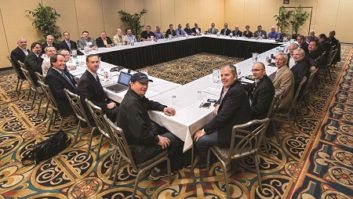This is Part 3 of a series about IT fundamentals. These articles are based on excerpts from the Society of Broadcast Engineers CBNT/CBNE Study Topics webinar series, designed to assist those seeking SBE certification and to provide others a broad overview of IT as used in broadcast engineering. (Read Part 1 and Part 2.)
The Internet Protocol Version 4 (IPv4) is the most common Internet Protocol (IP) address in use today. With any mention of an IP address, an IPv4 address is assumed or simply an IP address.
The familiar IP address is defined in detail by the Internet Engineering Task Force (IETF) Request for Comment (RFC) #791 finalized in 1981.
The 32-bit address provides some 4.2 billion (232) unique addresses. The address space is divided into five blocks or classes consisting of A, B, C, D and E expressed in the familiar doted-decimal format of four eight-bit octets or four bytes separated by a decimal yielding 192.168.1.1.
Class A, B and C are the most common addresses, with class D reserved for multicast use and class E for experimental use. Within class A, B and C address space additional reserved uses can be found such as private address blocks (often referred to as RFC 1918 space), loop-back and zero configuration address space (RFC #3927). At the end of the day, there are around 3.7 billion unique addresses useable for host assignment in the public internet address space.
Soon after adoption, it became apparent that the IP address space standard adopted was not going to be adequate to fulfill a rapidly growing demand.
In 1998, IETF RFC #2460 was issued. It outlined IPv6 as a solution to the demand for address space.
Lots (lots) of addresses
IPv6 provides a 128-bit address yielding some 340 undecillion or 3.4 x 1038 unique addresses. I will leave it to your imagination to grasp the size of even 1 undecillion of anything.
In an IPv6 environment, the address allocation focus becomes allocation of networks or subnets rather than individual IP address, as one does with IPv4 addresses. Auto-configuration features within the IPv6 protocol suite handle individual host IP address assignment and configuration. There are no subnet masks to deal with and CIDR notation is used exclusively.
One of the challenges of implementing IPv6 is changing one’s mindset to subnet allocation rather than address allocation and accepting multiple addresses per host interface. At a minimum, an IPv6 host will have a global unicast address, a unique local address and a link local address.
Faced with 128 bits to represent in some form of an address, the IPv6 address is formatted as eight groups of 16-bits (also known as quads) expressed in hexadecimal and separated by a colon yielding:
2607:b800:faa:3:f1e2:65b7:5675:1984
The IPv6 address may be daunting at first glance. The IPv6 address can be simplified by breaking it down into three parts: the routing prefix, the subnet ID and the interface ID.
The routing prefix represents the left-most 48 bits of the address and is assigned by a Regional Internet Registry or a service provider. The next field is the subnet ID that the broadcast IT engineer allocates for the site. And the right-most 64 bits of the address is configured automatically by the host or manually in a specified format by the engineer.
 IPv6 is far more than larger address space. It was an opportunity to reengineer the IP address scheme described in the original IETF RFC.
IPv6 is far more than larger address space. It was an opportunity to reengineer the IP address scheme described in the original IETF RFC.
Improvements or enhancements were made in reducing the IPv6 header size with fixed length fields and a larger payload size yielding faster packet processing in routers.
Another important advantage is the elimination of the need for Network Address Translation (NAT) as each host device has a unique address restoring the end-to-end host-host communications model that IP was founded upon.
IPv6 adoption has been slower than many predicted. NAT and private addressing have allowed many networks to extend the life of IPv4 without the expense of upgrading the infrastructure to one supporting IPv6.
Carrier Grade NAT (or double NAT) is often found in internet service provider networks, which can create complexity and adds latency to real-time media packet flows.
[Sign Up for Radio World’s SmartBrief Newsletter]
As the broadcast IT engineer looks ahead, consider IPv6 to be included in your network designs. A dual-stack approach accommodating both IPv4 and IPv6 is supported and allows a gradual migration. Major and regional Internet Service Providers (ISP) support IPv6 today, and more and more broadcast equipment suppliers are supporting in their products, as all major operating systems have been IPv6-compliant for some time.
Studies have shown that IPv6 connections are noticeably faster when compared to an IPv4 connection. One such Akamai study demonstrated that IPv6 web sites load on the order of 15 percent faster than on IPv4. For the broadcast station distributing real-time media, the gains can be significant to the consumer.
IPv6 is the future as the demand continues for internet-enabled host devices. The Internet Protocol was developed for Arpanet as a governmental research network.
Vincent Cerf is considered one of the fathers of the internet and headed the team that choose the 32-bit IP address scheme. He has stated, “Who the hell knew how much address space we needed for an experiment?”
The webinar on which this article is based, and many others, are available to anyone for a modest fee, with members receiving a discounted rate and free to those with the SBE MemberPlus upgrade. Consider joining if you are not a member at sbe.org.










